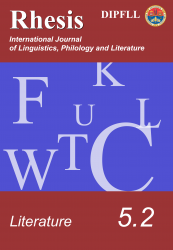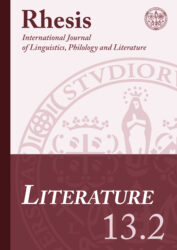 Literature
LiteratureVol. 5.2 - 2014
Download issue
Table of contents
| p. 5 | “Risibilia” bandelliani: le novelle di mottoMaria Antonietta CortiniAbstract In the wide bibliography on Bandello’s Novelle (the first Three Parts published in 1554, the Fourth, posthumous, in 1573), studies on comico are just a minority and exclusively concern the beffa in literary relationship with the novella tradition from Boccaccio to the Cinquecento. His novellas di motto – not many, not amongst his best, and most of all not modelled on the Decameron – represent, instead, a narrative type disappeared since about a century from the collections of novellas and by now integrated into the specific collections of facetiae. Most of these are rewritings of literary witticisms, often told within the frame of a conversazione cortigiana, similar to the one in the dedicatory epistle. The epistle allows Bandello to provide a theoretical justification for telling a piacevole motto or a series of piacevoli motti, in accordance with the great modern models de ridiculis (Pontano and Castiglione); however, both the epistles and the tales reveal how deeply the rhetoric and ethics of facetudo have changed.
|
| p. 42 | Meroveo, Basina e il mito dinastico dei FranchiCarlo DonàAbstract Nowadays the passages relating to the origins of the Merovingian dynasty interpolated by Pseudo-Fredegar into his version of Gregory of Tours’s Historia Francorum are mostly considered worthless fables. Nevertheless, they are truly interesting, particularly those concerning the legend that links Merovech’s birth to a mysterious bistea Neptuni quinotauri similis, and the puzzling story of Basina, Childerich’s Thuringian wife. The present essay aims at providing a new interpretation of these passages, appreciating them at their true value: as fragments of ancient legendary history, a mosaic, as it were, composed by actual historical records, old myths, and forgotten literature.
|
| p. 86 | Quisque est suae fortunae faber, o di come Marcello Fois paga un pegno di riconoscenza a Salvatore SattaLaura NiedduAbstract The novel Stirpe by Marcello Fois is an obvious tribute to Salvatore Satta’s work Il giorno del giudizio. By means of a system of references, clear citations as well as subtle allusions to his model, Fois has written a story which is also a celebration of his hometown, Nuoro, and which describes its changes as well as its contradictions. Stirpe, in addition, is not the only novel where Marcello Fois has honored his literary predecessors, as throughout his whole production the reader can notice the signs of the legacy of those he considers to be his models, first of all Salvatore Satta, as well as Grazia Deledda, Sebastiano Satta and Sergio Atzeni.
|
| p. 102 | Codificazione e formularità nella rappresentazione letteraria degli affetti. Note sul Tristano RiccardianoGioia ParadisiAbstract This paper aims to show that the description of affectivity in the Tristano Riccardiano mostly relies on formulaic expressions and repetitive discursive elements. Accordingly, the identification and definition of different types of formulae makes it possible to provide a new general understanding of emotions and feelings which define the affective dimension of the protagonist.
|
| p. 124 | Vaterhass e Mutterhass. Il tema del conflitto generazionale nell’opera di Josef Haslinger e Robert MenasseValentina SerraAbstract The vast and complex work of the Austrian writers Josef Haslinger and Robert Menasse, by developing several themes, sharply criticises the contemporary society and tends to reassert the role of intellectuals in the present. Through a large number of anti-heroes, mainly thinkers and writers unable to fit in a hostile social context, Haslinger and Menasse give a fresh impetus to the debate about the possible ‘mission’ of contemporary intellectuals. These assumptions develop within complex themes which characterize their writings, such as the conflict between children and parents, also caught in their relationship to the Nazi past. This work aims to analyze Haslinger’s and Menasse’s main works through the fil rouge of generational conflicts and, by means of well-known psychoanalytic theories, to contribute to the debate on the role of contemporary intellectuals.
|
| p. 148 | L’Aldilà tra meraviglioso e fantastico nella narrazione romanza e mediolatina alla fine del XII secolo (e inizi del XIII): Guigemar e Partenopeus de Blois, De Nugis Curialium (e Otia Imperialia)Lucilla SpetiaAbstract The birth of Purgatory as a physical intermediate place for the purgation in the Hereafter, according to Le Goff, dates back to the decades 1170-1180, in any case before the end of the twelfth century. It is accompanied by the production of two different types of literature — travel in the Hereafter and the presence of revenants — to justify the links between the dead and the living. With regard to the first type, the trip of Owein to Purgatory is considered as truthful testimony; at the same time it also brings attention to another real journey in the afterlife, that of Brendan and his monks. The influence of the two texts about Brendan (in Latin and in French) on the subsequent literature is remarkable mainly because they introduce wonderful themes and issues. In particular Partenopeus de Blois and Guigemar owe much to them, although the novel seems to welcome and reinterpret the ideology that underlies the journey, which proves its temporal priority on the lai. As for the revenants, they are mostly found in the narrative literature related to the Plantagenet court, as demonstrated by De Nugis Curialium and Otia imperialia. An examination of Map’s work, especially the story about mesnie Hellequin, shows that the clerk was aware of the most recent theological reflections on Purgatory.
|
Tags: affective formulaic language, analysis of the past, Bandello, Carlo Donà, Castiglione, celebration of Nuoro, facetiae, fantastic, Franks, Fredegar, generational conflict, Gioia Paradisi, Hereafter, Il giorno del giudizio, intellectuals, Italian Tristan texts, Josef Haslinger, Laura Nieddu, legendary history, literary tribute, Lucilla Spetia, Maria Antonietta Cortini, Merovingians, origines gentium, Pontano, Purgatory, revenants, Robert Menasse, Stirpe, tales, Tristano Riccardiano, Valentina Serra, wonderful
 LiteratureVol. 5.2 - 2014
LiteratureVol. 5.2 - 2014
